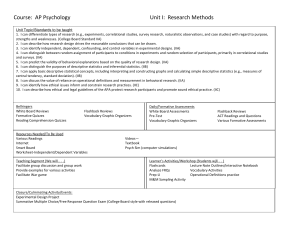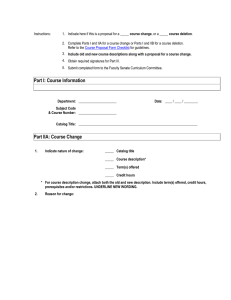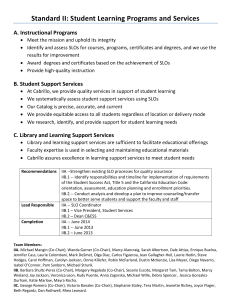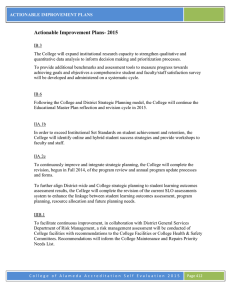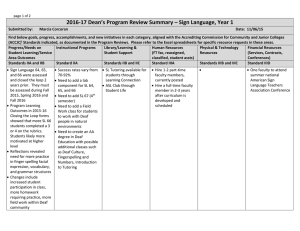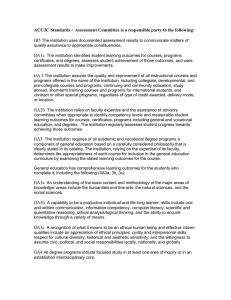CORRELATION OF STATE GUIDANCE PLAN AND ASCA'S NATIONAL STANDARDS
advertisement
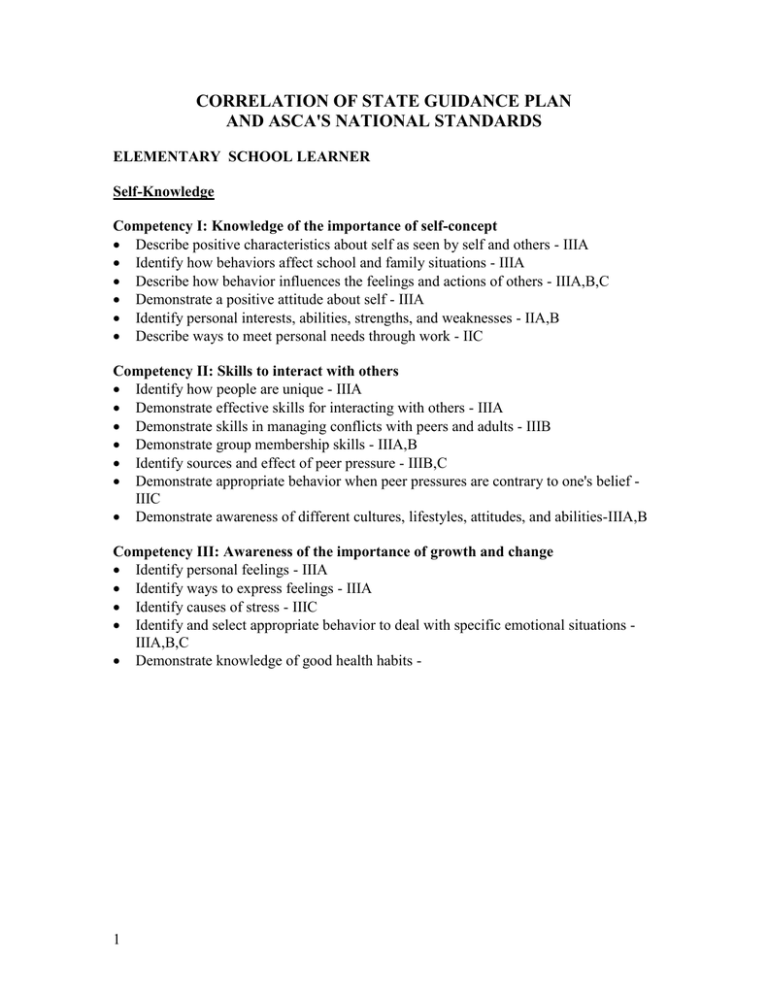
CORRELATION OF STATE GUIDANCE PLAN AND ASCA'S NATIONAL STANDARDS ELEMENTARY SCHOOL LEARNER Self-Knowledge Competency I: Knowledge of the importance of self-concept Describe positive characteristics about self as seen by self and others - IIIA Identify how behaviors affect school and family situations - IIIA Describe how behavior influences the feelings and actions of others - IIIA,B,C Demonstrate a positive attitude about self - IIIA Identify personal interests, abilities, strengths, and weaknesses - IIA,B Describe ways to meet personal needs through work - IIC Competency II: Skills to interact with others Identify how people are unique - IIIA Demonstrate effective skills for interacting with others - IIIA Demonstrate skills in managing conflicts with peers and adults - IIIB Demonstrate group membership skills - IIIA,B Identify sources and effect of peer pressure - IIIB,C Demonstrate appropriate behavior when peer pressures are contrary to one's belief IIIC Demonstrate awareness of different cultures, lifestyles, attitudes, and abilities-IIIA,B Competency III: Awareness of the importance of growth and change Identify personal feelings - IIIA Identify ways to express feelings - IIIA Identify causes of stress - IIIC Identify and select appropriate behavior to deal with specific emotional situations IIIA,B,C Demonstrate knowledge of good health habits - 1 Educational and Occupational Exploration Competency IV: Awareness of the benefits of educational achievement Describe how academic skills can be used in the home and community - IC Identify personal strengths and weaknesses in subject areas - IIA,B Identify academic skills needed in several occupational groups - IIB Describe relationships among ability, effort, and achievement - IB,IIC Implement a plan of action for improving academic skills - IB Implement a plan of action for improving academic skills - IB Describe school tasks that are similar to skills essential for job success - IIC Describe how the amount of education needed for different occupational levels varies IB,IIB Competency V: Awareness of the relationship between work and learning Identify different types of work, both paid and unpaid - IIA,B Describe the importance of preparing for occupations - IIA,B Demonstrate effective study and information-seeking habits - IA,B,IIB Demonstrate an understanding of the importance of practice, effort, and learning - IC Describe how current learning relates to work - IC,IIB,C Describe how one's role as a student is like that of an adult worker - IIC Competency VI: Skills to understand and use career information Describe work of family members, school personnel, and community workers IIA,IIIA Identify occupations according to data, people, and things - IIB Identify work activities of interest to the student - IIA,B Describe the relationship of beliefs, attitudes, interests, and abilities to occupations – IIB,C Describe jobs that are present in the local community - IIA Identify the working conditions of occupations - IIB Describe ways in which self-employment differs from working for others - IIA Describe how parents, relatives, adult friends, and neighbors can provide career information - IB Competency VII: Awareness of the importance of personal responsibility and good work habits Describe the importance of personal qualities to getting and keeping jobs - IIA Demonstrate positive ways of performing work activities - IIA Describe the importance of cooperation among workers to accomplish a task - IIA,C Demonstrate the ability to work with people who are different from oneself IIA,C,IIIA 2 Competency VIII: Awareness of how work relates to the needs and functions of society Describe how work can satisfy personal needs - IIC Describe the products and services of local employers Describe ways in which work can help overcome social and economic problems - IIC Career Planning Competency IX: Understanding how to make decisions Describe how choices are made - IIA,IIIB Describe what can be learned from making mistakes - IA, IIIC Identify and assess problems that interfere with attaining goals - IIA Identify strategies used in solving problems - IIIB Identify alternatives in decision making situations - IIA, IIIB Describe how personal beliefs and attitudes effect decision making - IIIB Describe how decisions affect self and others - IIIB Competency X: Awareness of the interrelationship of life roles Describe the various roles an individual may have - IIIA Describe work-related activities in the home, community and school - IIB Describe how family members depend on one another, work together, and share responsibilities - IIIA,B Describe how work roles complement family roles - IC,IIIA Competency XI: Awareness of different occupations and changing male/female roles Describe how work is important to al people – IIC Describe the changing life roles of men and women in work and family – IIC, IIIC Describe how contributions of individuals, both inside and outside the home, are important – IIIC Competency XII: Awareness of the career planning process Describe the importance of planning – IIC Describe skills needed in a variety of occupational groups – IIB Develop an individual career plan for the elementary school level – IIB 3 MIDDLE/JUNIOR HIGH SCHOOL STUDENT Self-Knowledge Competency I: Knowledge of the influence of a positive self concept Describe personal likes and dislikes – IIIA Describe individual skills required to fulfill different life roles – IIB Describe how one’s behavior influences the feelings and actions of others – IIIA Identify environmental influences on attitudes, behaviors, and aptitudes – IIIC Competency II: Skills to interact with others Demonstrate respect for the feelings and beliefs of others – IIIA Demonstrate an appreciation for the similarities and differences among people – IIIA Demonstrate tolerance and flexibility in interpersonal and group situations – IIIA Demonstrate skills in responding to criticism – IIIA,B Demonstrate effective group membership skills – IIIA,B Demonstrate understanding of different cultures, lifestyles, attitudes, and abilities – IIIA Competency III: Knowledge of the importance of growth and change Identify feelings associated with significant experiences – IIIA Identify internal and external sources of stress – IIIC Demonstrate ways of responding to others when under stress – IIIC Describe changes that occur in the physical, psychological, social, and emotional development of an individual - IIIA Describe physiological and psychological factors as they relate to career development – IIIC Describe the importance of career, family, and leisure activities to mental, emotional, physical, and economic well-being – IIC Educational and Occupational Exploration Competency IV: Knowledge of the benefits of educational achievement to career opportunities Describe the importance of academic and occupational skills in the work world – IC Identify how the skills taught in school subjects are used in various occupations – IC Describe individual strengths and weaknesses in school subjects – IIA,B Describe a plan of action for increasing basic educational skills – IB Describe the skills needed to adjust to changing occupational requirements – IC, IIC Describe how continued learning enhances the ability to achieve goals – IIC Describe how skills relate to the selection of high school courses of study – IIB Describe how aptitudes and abilities relate to broad occupational groups – IIB 4 Competency V: Understanding the relationship between work and learning Demonstrate effective learning habits and skills – IA,B,C Demonstrate an understanding of the importance of personal skills and attitudes to job success – IIA Describe the relationship of personal attitudes, beliefs, abilities, and skills to occupation –IIA,B,C Competency VI: Skills to locate, understand, and use career information Identify various ways that occupations can be classified – IIB Identify a number of occupational groups for exploration – IIB Demonstrate skills in using school and community resources to learn about occupational groups – IIA,B Identify sources to obtain information about occupational groups including selfemployment – IIA,B Identify skills that are transferable from one occupation to another – IIB,C Identify sources of employment in the community – Competency VII: Knowledge of skills necessary to seek and obtain jobs Demonstrate personal qualities that are needed to get and keep jobs – IIA,B Describe terms and concepts used in identifying employment opportunities and conditions - IIA Demonstrate skills to complete a job application – IIA Demonstrate skills and attitudes essential for a job interview – IIA Competency VIII: Understanding how work relates to the needs and functions of the economy and society Describe the importance of work to society - IIC Describe the relationship between work and economic and societal needs – IIC Describe the economic contributions workers make to society – IIC Describe the effects that societal, economic, and technological change have on occupations – IIC Career Planning Competency IX: Skills to make decisions Describe personal beliefs and attitudes – IIA Describe how career development is a continuous process with series of choices – IIB Identify possible outcomes of decisions – IIB,IIIB Describe school courses related to personal, educational, and occupational interests – IIB Describe how the expectations of others affect career planning – IIB,IIIB Identify advantages and disadvantages of various secondary and postsecondary programs for the attainment of career goals – IB Identify the requirements for secondary and postsecondary programs – IB 5 Competency X: Knowledge of the interrelationship of life roles Identify how different work and family patterns require varying kinds and amounts of energy, participation, motivation, and talent – IB,IIC Identify how work roles at home satisfy needs of the family - IIC Identify personal goals that may be satisfied through a combination of work, community,social, and family roles – IIA,C Identify personal leisure choices in relation to lifestyle and the attainment of future goals – IIA,C Describe advantages and disadvantages of various life role options – IIB Describe the interrelationships between family, occupational, and leisure decisions – IIA Competency XI: Knowledge of different occupations and changing male/female roles Describe advantages and problems of entering nontraditional occupations – IIA Describe the advantages of taking courses related to personal interests, even if they aremost often taken by members of the opposite gender – IB,IIC Describe stereotypes, biases, and discriminatory behaviors that may limit opportunities for women and men in certain occupations – IIC Competency XII: Understanding the process of career planning Demonstrate knowledge of exploratory processes and programs – IIA Identify school courses that meet tentative career goals – IIB Demonstrate knowledge of academic and vocational programs offered at the high school level- IIB Describe skills needed in a variety of occupations, including self-employment – IIA,B Identify strategies for managing personal resources to achieve tentative career goals – IC,IIA Develop an individual career plan, updating information from the elementary-level plan and including tentative decisions to be implemented in high school – IB,IIB Identify and appreciate personal interests, abilities, and skills – IIA,B Demonstrate the ability to use peer feedback – IIB,C Demonstrate an understanding of how individual characteristics relate to achieving personal, social, educational, and career goals – IC,IIIA,B Demonstrate an understanding of environmental influences on one’s behavior – IIIC Demonstrate an understanding of the relationship between personal behavior and selfconcept – IIIA 6 HIGH SCHOOL STUDENT Self-Knowledge Competency I: Understanding the influence of a positive self-concept Identify and appreciate personal interests, abilities, and skills – IIA,IIIA Demonstrate the ability to use peer feedback – IIIC Demonstrate an understanding of how individual characteristics relate to achieving personal, social, educational, and career goals – IB,IIA,B Demonstrate an understanding of environmental influences on one’s behavior – IIIC Demonstrate an understanding of the relationship between personal behavior and selfconcept –IIIA Competency II: Skills to interact positively with others Demonstrate effective interpersonal skills –IIIA,B,C Demonstrate interpersonal skills required for working with and for others – IIIA,B,C Describe appropriate employer and employee interactions in various situations – IIA Demonstrate how to express feelings, reactions, and ideas in an appropriate manner – IIIA Competency III: Understanding the impact of growth and development Describe how developmental changes affect physical and mental health – IIIA,B,C Describe the effect of emotional and physical health on career decisions – IIA Describe healthy ways of dealing with stress – IIIC Demonstrate behaviors that maintain physical and mental health – IIIC Educational and Occupational Exploration Competency IV: Understanding the relationship between educational achievement and career planning Demonstrate how to apply academic and vocational skills to personal interests – IIA,B Describe the relationship of academic and vocational skills to personal interests – IIA,B Describe how skills developed in academic and vocational programs relate to career goals – IB,C Describe how education relates to the selection of college majors, further training, and/or entry into the job market – IB,C Demonstrate transferable skills that can apply to a variety of occupations and changing occupational requirements – IIC Describe how learning skills are required in the workplace – IC 7 Competency V: Understanding the need for positive attitudes toward work and learning Identify the positive contributions workers make to society – IIC Demonstrate knowledge of the social significance of various occupations – IIC Demonstrate a positive attitude toward work – IIA Demonstrate learning habits and skills that can be used in various educational situations - IIA Demonstrate positive work attitudes and behaviors – IIA Competency VI: Skills to locate, evaluate, and interpret career information Describe the educational requirements of various occupations – IIB Demonstrate use of a range of resources – IIB Demonstrate knowledge of various classification systems that categorize occupations and industries – IIB Describe the concept of career ladders – IIB Describe the advantages and disadvantages of self-employment as a career option – IIB Identify individuals in selected occupations as possible information resources, role models, or mentors –IB, IIC Describe the influence of change in supply and demand for workers in different occupations – Identify how employment trends relate to education and training – IIC Describe the impact of factors such as population, climate, and geographic location on occupational opportunities – IIB Competency VII: Skills to prepare to seek, obtain, maintain, and change jobs Demonstrate skills to locate, interpret, and use information about job openings and opportunities – IIB Demonstrate academic or vocational skills required for a full-time or part-time job – IC,IIA Demonstrate skills and behaviors necessary for a successful job interview – IIA Demonstrate skills in preparing a resume and completing job applications – IIA Identify specific job openings – Demonstrate skills to assess occupational opportunities – IIB Describe placement services available to make the transition from high school to civilian employment, the armed services or postsecondary education/training - IIB Demonstrate an understanding that job opportunities often require relocation – IIB Demonstrate skills necessary to function as a consumer and manage financial resources – IIC 8 Competency VIII: Understanding how societal needs and functions influence the nature and structure of work Describe the effect of work on lifestyles – IIC Describe how society’s needs and functions affect the supply of goods and services – IIC Describe how occupational and industrial trends relate to training and employment – IIC Demonstrate an understanding of the global economy and how it affects each individual – Competency IX: Skills to make decisions Demonstrate responsibility for making tentative educational and occupational choices –IB,C,IIB Identify alternatives in given decision making situations – IIIB Describe personal strengths and weaknesses in relationship to postsecondary education training requirements – IB Identify appropriate choices during high school that will lead to marketable skills for entry-level employment or advanced training – IB,C Identify and complete required steps toward transition from high school to entry into postsecondary education/training programs or work – IB,C Identify steps to apply for and secure financial assistance for postsecondary education and training Competency X: Understanding the interrelationship of life roles Demonstrate knowledge of life stages – IIIA Describe factors that determine lifestyles – IIC Describe ways in which occupational choices may affect lifestyle – IIC Describe the contribution of work to a balanced and productive life – IIC Describe ways in which work, family, and leisure are interrelated – IIA Describe different career patterns and their potential effect on family patterns and lifestyle – IIC Describe the importance of leisure activities - IIA Demonstrate ways that occupational skills and knowledge can be acquired through leisure – IIA Competency XI: Understanding the continuous changes in male/female roles Identify factors that have influenced the changing career patterns of women and men – IIC Identify evidence of gender stereotyping and bias in educational programs and occupational settings – IIC Demonstrate attitudes, behaviors, and skills that contribute to eliminating gender bias and stereotyping – IIC Identify courses appropriate to tentative occupational choices – IB,IIB Describe the advantages and problems of nontraditional occupations – IIA 9 Competency XII: Skills in career planning Demonstrate career plans that reflect the importance of lifelong learning – IIC Demonstrate knowledge of postsecondary vocational and academic programs – IIB Demonstrate knowledge that changes may require retraining and upgrading of employees’ skills – IIC Describe school and community resources to explore educational and occupational choices – IB,IIB Describe the costs and benefits of self-employment – IIA Demonstrate occupational skills developed through volunteer experiences, part-time employment, or cooperative educational programs – IIA,B Demonstrate skills necessary to compare education and job opportunities – IIB Develop an individual career plan, updating information from earlier plans, and including tentative decisions to be implemented after high school – IIB 10
